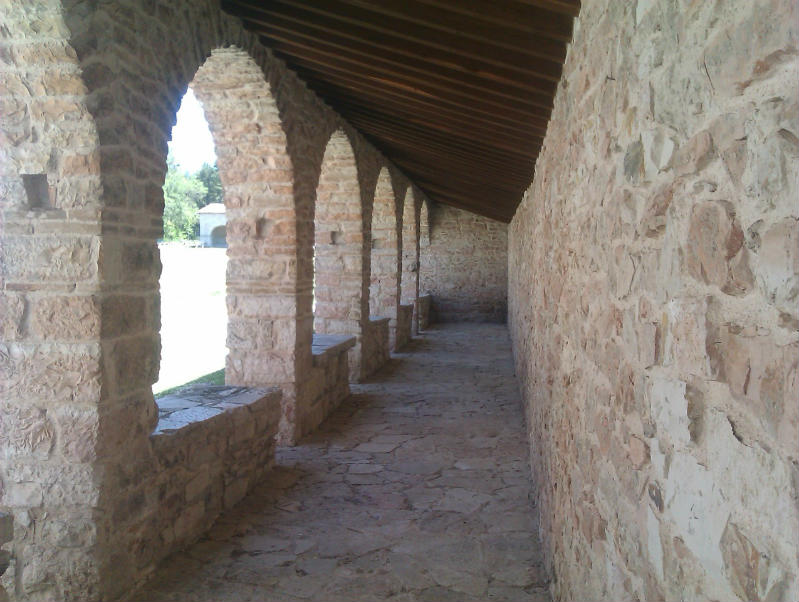Mostly, I feel very comfortable spending my time in the rolling hills and the valley of Umbria. Being afraid of heights, I never felt the urge to reach a higher level. Of course, I was aware there was a part of Umbria called the Valnerina, and another, the Monti Sibillini, because I had to cross them to visit Norcia. It was merely a beautiful pastime to reach my ham and truffles and the only way to head for the Piano Grande and Castelluccio, but I never really gave it a second thougt.
How things can change in life! This year, I spent summer in Borgiano di Spoleto at 650 m. and woke up every morning to stunning views of the surrounding environments. I got more than interested and wanted to see all of it.
The first trip I made was meant to roam around and stop in villages or hamlets that looked fine, but I found out they all did so I decided to visit Vallo di Nera to start with.
This little village, surrounded by walls, is very well kept and offers a flash back to the Middle Ages. Its small squares and narrow alleys led me to one of the three Roman Churches, the San Giovanni Battista.
Outside the church, a very, very old man approached me and (I think) asked me if I understood English. When I said I did, he said `Heeeelllloww` which appeared to be his only English so we agreed happily that he would open the doors for me with an enormous key. The interior revealed some splendid frescos. The one in the apsis is a 16th century masterpiece.
After that, a walk outside the walls showed two impressive gates and an imposive abbey that, unfortunately, turned out to be closed. But that leaves me something to wish for.
I continued my journey towards Norcia and this time – with the utmost effort – I succeeded in ignoring it. After all, truffle season had not started yet. Instead I drove to the Piano Grande because there is nothing as beautiful as this wide plateau in full flower. I love it in winter when it´s covered by snow, but few things compare to the view in spring and early summer. It is an excellent spot for horse trekking too.

Of course, I took a coffee break in Castelluccio, famous for its lentils that you can buy nearly everywhere in the village. The village itself is picturesque, with amazing views of the surrounding landscape on almost every corner.
Sipping my espresso I realized that it would be impossible to see the entire Valnerina and besides, it was such a nice excuse to return the next day. So I changed plans and wanted to take a scenic route through the woods. I ran into the first gorgeous obstacle right after leaving Castelluccio: a huge sheepdog on the middle of the road. Just when I gathered the courage to make it move, a shepherd with his sheep showed up. It seemed no end to the flow of sheep but finally, they found their grass and I could continue, completely in love with the countrylife by that time.
Collecting one beautiful view after another I reached Visso, which is situated at the Umbrian border, in The Marche. The most characteristic spot in Visso is its wide piazza, flanked by two Medieval churches. One of them houses a museum worth visiting. Visso´s centre contains various interesting buildings, like the Palazzo dei Priori and the Palazzo del Divino Amore (palace of divine love), but don´t forget to walk along the banks of the Ussita, a side river of the Nera river.
I had a nice plate of Pappardelle al Cinghiale (pasta with wild boar) for lunch and then left for Colfiorito. On my way I made a stop at the Santuario di Macereto. It is a big, symmetric building on a location that exudes a serene peace, but maybe that was because it was closed at that time of day. I will certainly go back there to find out. It is very well restored and preserved.
Driving on, the superb views came to no end and not only am I convinced that both the Valnerina and the Monti Sibillini are very good places to be: I think I have become addicted.
I made my last stop at the Colfiorito plains to buy some red potatoes from a local farmer for my dinner. He asked me if I liked the region. I told him yes, and thought that it is way beyond liking.
It is pure love.











I love Umbria as well. I lived in Perugia for 10 years.
I don’t admit it easily, but I never visited any of the villages you feature in this post, although I drove many times around places and valleys you are talking about.
But this Italy: there are countless beautiful, ancient and peaceful villages. You can discover new ones everywhere, often finding some very close to home you didn’t even suspect existed until a moment before.
And by the way, last time I crossed Colfiorito, I actually… stopped by to buy red potatoes!
It is my opinion that whatever the world has to show us, either in Italy and anywhere else, is for everybody from everywhere to enjoy. Happy you liked Umbria. It belongs to mankind, to all of us.
It looks like a beautiful countryside. Its amazing how well preserved the centuries old art is.
The wide plateau of flowers reminded me of another plateau we have here in India, in the western state of Maharashtra.(Ofcourse, its never covered in snow in the winters). Its a place called Kaas which is part of the western ghats, that were recently enlisted as a UNESCO world heritage site.
Thank you very much for you comment. I am glad Unesco enlists some spots as world heritage, we schould take could care of all the beauty that is left in our world.